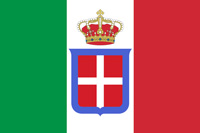World War I (1914-1918)

Sixth Battle of the Isonzo
The Sixth Battle of the Isonzo also known as the Battle of Gorizia was the most successful Italian offensive along the Soča (Isonzo) River during World War I.
Background
Franz Conrad von Hötzendorf had reduced the Austro-Hungarian forces along the Soča (Isonzo) front to reinforce his Trentino Offensive. Italian Chief-of-Staff Luigi Cadorna made good use of railroads to quickly shift troops from Trentino back to the Isonzo line for an offensive against the weakened Austro-Hungarian Austria-Hungary, often referred to as the Austro-Hungarian Empire, the Dual Monarchy, or Austria, was a constitutional monarchy and great power in Central Europe between 1867 and 1918. Austria-Hungary was one of the Central Powers in World War I, which began with an Austro-Hungarian war declaration on the Kingdom of Serbia on 28 July 1914. defenses.
Austria-Hungary, often referred to as the Austro-Hungarian Empire, the Dual Monarchy, or Austria, was a constitutional monarchy and great power in Central Europe between 1867 and 1918. Austria-Hungary was one of the Central Powers in World War I, which began with an Austro-Hungarian war declaration on the Kingdom of Serbia on 28 July 1914. defenses.
Battle
On 6 August the offensive was launched against Gorizia. The offensive was concentrated in two zones: the hilly area west of the Soča (Isonzo) river near Gorizia the westernmost edge of the Karst Plateau near Doberdò del Lago. In the Battle of Doberdò, the Italians The Kingdom of Italy was a state that existed from 1861, when Victor Emmanuel II of Sardinia was proclaimed King of Italy, until 1946. The state resulted from a decades-long process, the Risorgimento, of consolidating the different states of the Italian Peninsula into a single state. That process was influenced by the Savoy-led Kingdom of Sardinia, which can be considered Italy's legal predecessor state. managed to conquer the main transport road leading from the coast town of Duino to Gorizia, thus securing their advance to Gorizia from the south. The Austro-Hungarian forces had to retreat on the line east of Gorizia (Mount Škabrijel), leaving the heavily damaged town to the Italians.
The Kingdom of Italy was a state that existed from 1861, when Victor Emmanuel II of Sardinia was proclaimed King of Italy, until 1946. The state resulted from a decades-long process, the Risorgimento, of consolidating the different states of the Italian Peninsula into a single state. That process was influenced by the Savoy-led Kingdom of Sardinia, which can be considered Italy's legal predecessor state. managed to conquer the main transport road leading from the coast town of Duino to Gorizia, thus securing their advance to Gorizia from the south. The Austro-Hungarian forces had to retreat on the line east of Gorizia (Mount Škabrijel), leaving the heavily damaged town to the Italians.
On 8 August, Gorizia fell to Cadorna and a bridgehead was finally established across the Soča (Isonzo) River. The Austro-Hungarians shifted troops to the Gorizia sector to prevent a breakthrough. Content with having established the bridgehead, Cadorna ended the offensive on 17 August.
The attack on Gorizia was the most successful Italian offensive along the Isonzo lines and greatly boosted Italian morale - especially since Gorizia had been promoted as a desirable objective, unattainable in earlier battles. In the wake of the battle Italy finally declared war against Germany The German Empire, also referred to as Imperial Germany, the Second Reich, as well as simply Germany, was the period of the German Reich from the unification of Germany in 1871 until the November Revolution in 1918, when the German Reich changed its form of government from a monarchy to a republic. During its 47 years of existence, the German Empire became the industrial, technological, and scientific giant of Europe. , on 28 August.
The German Empire, also referred to as Imperial Germany, the Second Reich, as well as simply Germany, was the period of the German Reich from the unification of Germany in 1871 until the November Revolution in 1918, when the German Reich changed its form of government from a monarchy to a republic. During its 47 years of existence, the German Empire became the industrial, technological, and scientific giant of Europe. , on 28 August.
The Austrians, who were better equipped, preferred to preserve their forces. The Italian generals, in an attempt to make up for their poor equipment, committed the Italians to frontal assaults, resulting in massive casualties.
If one compares the number of dead Italians and the number of dead Austrians, the one sided-ness of the proportion highlights the high cost to this limited victory. In addition, like all other battles on the Soča (Isonzo), there were many missing soldiers, victims of the superior Austrian artillery.
HISTORY

RESOURCES
This article uses material from the Wikipedia articles "World War", "World War I", and "Sixth Battle of the Isonzo", which is released under the Creative Commons Attribution-Share-Alike License 3.0.
© Stories Preschool. All Rights Reserved.










